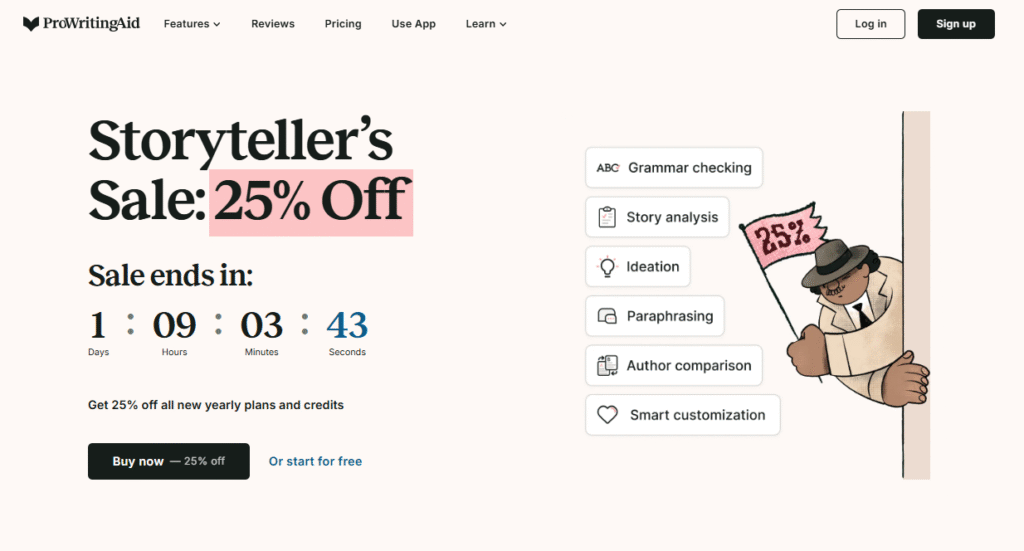The rise of AI-powered writing tools has given us digital companions that offer real-time feedback and creative support. But when it comes to the standout leaders in this space, how do you decide between them?
In the ultimate face-off of Grammarly vs ProWritingAid, it’s not just about who catches more errors—it’s about which tool aligns with your voice, goals, and writing process. Whether you’re a student, novelist, marketer, or blogger, this comparison will help you choose the right AI writing partner.
What is Grammarly?
Grammarly is like that detail-oriented friend who always has your back. Used by millions around the world, it’s much more than a spellchecker. Grammarly combines advanced AI with a user-friendly interface to help you write clearly, confidently, and effectively across platforms. It’s designed for people who need to produce polished writing quickly—whether you’re sending emails, writing reports, or posting on social media.

One of Grammarly’s biggest strengths is its generative AI capability. It doesn’t just fix mistakes; it can help you brainstorm ideas, outline articles, summarize content, and even adjust your tone to suit your audience. Its real-time tone detector is especially useful for professional communication, helping you sound more persuasive, friendly, or formal depending on the context.
Grammarly works wherever you do—it integrates with browsers, Microsoft Office, mobile devices, and even desktop apps. For anyone who values efficiency and consistency, Grammarly is a reliable choice.
Pros and Cons of Grammarly
Pros:
- Quick, accurate grammar, spelling, and punctuation corrections.
- Generative AI helps with rewriting, ideation, and summarization.
- Real-time tone suggestions improve communication effectiveness.
- Multi-platform support: web, desktop, mobile, and browser extensions.
Cons:
- Less tailored for long-form creative writing, such as novels or scripts.
- Style and structure feedback can be surface-level compared to deeper editing tools.
What is ProWritingAid?
If Grammarly is the friendly editor who helps you tidy up your writing, ProWritingAid is the writing coach who helps you transform it. This tool is built for writers who want to do more than correct errors—they want to refine their style, strengthen their narratives, and develop their unique voice. ProWritingAid offers in-depth reports on everything from pacing and sentence variety to sensory detail and dialogue tags, making it a favorite among authors, editors, and content creators.

A standout feature is its “Sparks” function, which acts as a brainstorming assistant. It helps overcome writer’s block by generating ideas, suggesting stronger verbs, or offering alternative phrasing. Plus, for writers concerned about privacy, ProWritingAid assures users that their content is not used to train AI models.
While it doesn’t have a dedicated mobile app, its desktop and web apps are powerful. If you’re looking to deepen your writing craft—whether you’re working on a book, blog, or essay—ProWritingAid offers the tools to help you grow.
Pros and Cons of ProWritingAid
Pros:
- Delivers detailed reports on readability, style, and structure.
- Excellent for fiction and creative writing with genre-aware suggestions.
- Includes brainstorming and rewriting tools designed for storytellers.
- Strong privacy policy—your writing isn’t used to train AI.
Cons:
- No native mobile application for iOS or Android.
- Generative AI features are less robust than Grammarly’s.
Grammarly vs ProWritingAid: Key Features Compared
Now that we’ve introduced both tools, let’s see how they stack up in a head-to-head comparison. We’ll look at some of the most important features writers care about—from plagiarism detection to customization.
1. Plagiarism Detection
Both Grammarly and ProWritingAid offer plagiarism detection, but there are differences in how they work. Grammarly’s Premium plan includes unlimited plagiarism checks, scanning your text against billions of web pages and published works. It’s straightforward, reliable, and especially useful for students and professionals.
ProWritingAid also offers plagiarism detection, but it operates on a credit system. You purchase checks individually or in packs, which may become costly for frequent users. While accurate, the pay-per-use model makes Grammarly a better value for those who regularly need plagiarism verification.
2. Style, Clarity, and Tone Recommendations
When it comes to enhancing writing style, the two tools take different approaches. Grammarly focuses on clarity, conciseness, and tone, making it ideal for business and academic writing. Its suggestions are practical and easy to implement, helping you communicate more effectively without getting bogged down.
ProWritingAid, on the other hand, offers comprehensive reports that analyze your writing at a deeper level. It identifies overused words, vague phrasing, repetitive sentence structures, and more. This makes it especially useful for writers working on long-form content—novels, research papers, or articles—where style and flow are critical.
3. Grammar and Spelling Checks
Both tools excel at catching grammar and spelling errors, but Grammarly is often faster and more intuitive for real-time editing. Its AI highlights mistakes as you type and offers one-click corrections.
ProWritingAid also catches errors effectively but places them within broader reports. This helps you understand patterns in your writing—like whether you rely too heavily on adverbs or passive voice—so you can learn and improve over time.
4. Readability Analysis
ProWritingAid is the clear winner when it comes to readability analysis. It uses metrics like Flesch Reading Ease, sentence length variation, and paragraph structure to give you actionable feedback. You’ll see exactly which sentences are hard to read and how to simplify them.
Grammarly offers a readability score and basic suggestions but doesn’t provide the same depth. If you’re writing for online audiences or publications where readability is key, ProWritingAid’s detailed feedback is invaluable.
5. Supported Platforms and Integrations
Grammarly is available nearly everywhere: Windows, Mac, iOS, Android, and via browser extensions for Chrome, Safari, and Edge. Its seamless integration across devices makes it perfect for people who write on the go.
ProWritingAid offers desktop apps for Mac and Windows and a web-based application, but it lacks dedicated mobile apps. While you can use it on mobile browsers, the experience isn’t as smooth. If mobility is a priority, Grammarly is the better choice.
6. Customization and Learning Support
ProWritingAid offers robust customization—you can adjust which reports you see, create custom style guides, and set writing goals based on genre (e.g., fiction, academic, business). It’s built for writers who want control over their editing process.
Grammarly allows for some customization, too, like setting your tone goal and dialect preference (American, British, etc.). However, it’s generally more automated. Both tools help you learn as you write, but ProWritingAid’s approach is more educational.
Conclusion on Grammarly vs ProWritingAid
So, where does the Grammarly vs ProWritingAid debate leave us? Each tool serves a different kind of writer—and the right choice depends on what you need most.
Go with Grammarly if you want a user-friendly, all-in-one writing assistant for everyday use. It’s perfect for students, professionals, and casual writers who need to produce clear, mistake-free writing quickly and across multiple platforms. With its powerful AI, tone detection, and plagiarism checker, Grammarly helps you communicate with confidence wherever you write.
Choose ProWritingAid if you’re a creative writer, author, or anyone focused on improving their writing craft. Its in-depth reports, style suggestions, and storytelling tools make it ideal for novels, blogs, and long-form content. If you’re ready to move beyond basic grammar and refine your unique voice, ProWritingAid is like having a personal writing coach.
Whatever you decide, remember that the goal isn’t perfection—it’s progress. Both Grammarly and ProWritingAid are here to help you become a better writer, one word at a time.



